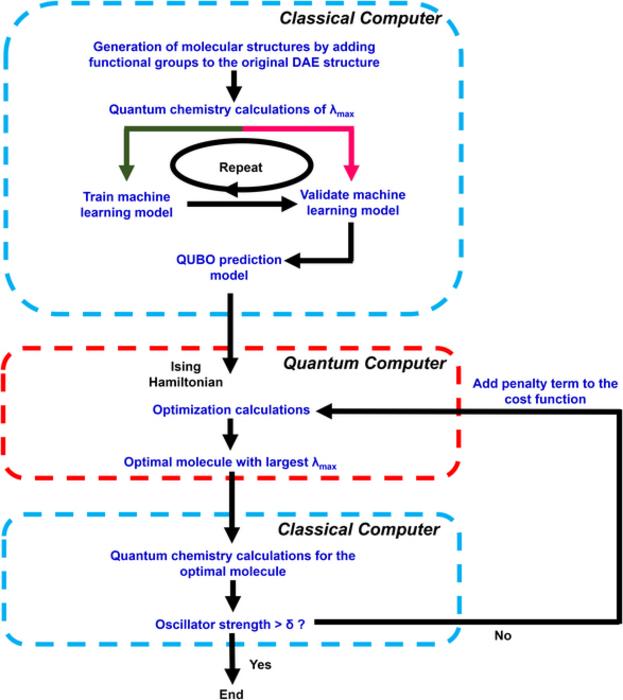In recent advancements at the intersection of quantum computing and material science, researchers have developed a groundbreaking quantum-classical computing method aimed at fortifying the design of photochromic materials. These compounds, which respond dynamically to light, could revolutionize various applications, particularly in the burgeoning field of photopharmacology. This remarkable research was published in “Intelligent Computing,” an esteemed journal, on December 20, 2024, further solidifying the significance of the findings in the scientific community.
The collaborative research group delved deep into their previous work, which laid the foundation for their latest innovations. By employing a computational-basis variational quantum deflation method, the team meticulously refined their approach to yield more accurate predictions of molecular properties. This methodological evolution paves the way for speeding up the material discovery process, a critical step considering the increasing demand for novel compounds in scientific and medical applications.
The methodology employed in identifying these optimal diarylethene derivatives is multifaceted. Initially, the researchers generated a variety of molecular structures and conducted quantum chemistry calculations on a subset of 384 diarylethene derivatives. This preparatory phase set the stage for detailed analysis, as the team subsequently harnessed machine learning techniques to extrapolate property predictions across the entire dataset of 4,096 derivatives effectively. This strategic combination of classical predictions bolstered by machine learning constitutes a significant leap for computational chemistry.
Furthermore, the team optimized their predictions using a quantum computer, adeptly identifying molecules that possess exceptionally large maximum absorbance wavelengths through the application of an Ising Hamiltonian, a sophisticated mathematical model. The Ising model is notable for its utility in depicting complex systems, making it particularly appropriate for the challenges encountered in material design. The culmination of this quantum optimization yielded stellar candidates ready for further evaluation.
A particularly innovative aspect of this research was the utilization of quantum computations to simulate specific states of the Ising model. By employing a 12-qubit quantum calculation, researchers could accurately simulate not just the ground state—the lowest energy state of the system—but also the first four excited states. This level of complexity is essential for discovering diarylethene derivatives with optimal absorbance properties, enhancing the chances of significant breakthroughs in photopharmacology applications.
Subsequent quantum chemistry calculations reaffirmed the results obtained during the quantum optimization phase. By examining the contributions of molecular orbitals to the absorbance characteristics of the identified candidates, the team further informed the design parameters for new diarylethene derivatives. This synthesis of insights maximizes the potential for breakthroughs in materials science while ensuring that new compounds exhibit both desirable absorbance and functional strengths.
Though the integration of quantum chemistry with machine learning has shown considerable promise in expediting novel material discoveries, the research still encounters fundamental hurdles. Challenges such as the scope and quality of training datasets, combined with intricacies involved in navigating extensive chemical spaces using discrete optimization methods, are prevalent. The team’s hybrid quantum-classical methodology not only demonstrates capability in overcoming these obstacles but also unveils potential pathways for discovering a diverse range of materials that may have fundamental applications across various scientific domains.
The multidisciplinary approach of melding quantum computing with classical physics experiments and machine learning not only enhances the understanding of molecules being examined but also enriches the research processes. The adaptability of their new method signifies a transformative shift in how materials are studied, characterized, and optimized. This is particularly relevant in the pharmaceutical sector, where time and resource efficiency are of utmost importance.
In summary, this groundbreaking research symbolizes a robust fusion of classical and quantum methodologies in material design, specifically for photochromic applications. The potential auditory of these discoveries echo throughout disciplines, emphasizing the necessity for ongoing investigation and collaborative efforts towards innovative solutions in material science. The continual evolution of principles in quantum computing, paired with practical applications, is poised to yield not just promising scientific advancements, but also pragmatic solutions to current challenges in the field.
In conclusion, the collaborative effort of this research team not only showcases a cutting-edge methodological framework but also sets the stage for a new epoch in materials design, ultimately benefiting fields as wide-ranging as photopharmacology and beyond. As science relentlessly progresses, the lines between computational power and experimental validation increasingly blur, heralding a future where novel materials can be engineered with precision like never before.
Subject of Research: Quantum-Classical Method Applied to Material Design
Article Title: A Quantum-Classical Method Applied to Material Design: Photochromic Materials Optimization for Photopharmacology Applications
News Publication Date: 20-Dec-2024
Web References: Intelligent Computing
References: 10.34133/icomputing.0037, 10.34133/icomputing.0108
Image Credits: Qi Gao et al.
Keywords
Quantum Computing, Photochromic Materials, Photopharmacology, Machine Learning, Material Design, Quantum Mechanics, Optical Properties, Ising Hamiltonian, Molecular Modeling, Computational Chemistry, Advanced Materials.
Tags: advancements in photochromic materialsbreakthroughs in material science researchcollaboration in scientific researchcomputational methods in material sciencediarylethene derivatives analysisdynamic light-responsive compoundsinnovative material discovery techniquesmolecular property predictionsphotopharmacology applicationsquantum computing in material designtargeted drug delivery systemsvariational quantum deflation method





